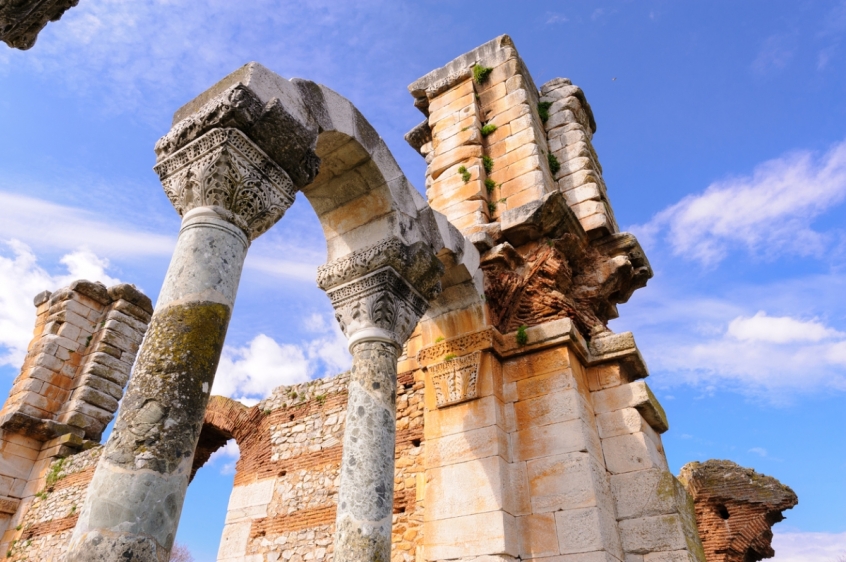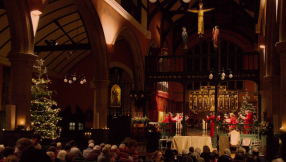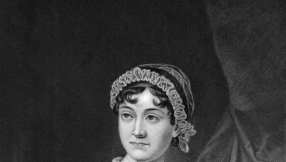
The writer of the Letter to the Hebrews reminds Christians that they are surrounded by a great "cloud of witnesses." (NRSV) That "cloud" has continued to grow in size since then. In this monthly column we will be thinking about some of the people and events, over the past 2000 years, that have helped make up this "cloud." People and events that have helped build the community of the Christian church as it exists today.
What was it like to be a member of the early church? What kind of community was it? We get some idea from the evidence of the New Testament in the Acts of the Apostles and in the community issues that appear in the letters. However, in the case of the letters, we tend to only get occasional glimpses of the kind of community emerging, since these were generally written in response to a particular set of pressing needs, not as a wide-ranging sociological presentation.
This is because the writers had more pressing things on their minds than writing a sociological or ecclesiological essay entitled 'Characteristics of Emerging Fresh Expressions Communities and Ministry.' Nevertheless, the documents of the New Testament give us a range of insights into a number of social, sexual, economic, and ethnic characteristics, tensions, questions, and conflict resolutions, in the emerging community.
But how did outsiders see them? How did their opponents perceive them? While this is fraught with potential and actual difficulties due to the 'Three Ms' of misinformation, misunderstandings, and mischief, this still provides some intriguing evidence.
When seen through the eyes of non-Christian imperial writers, what emerges is a picture of an extraordinary radical community that was making waves due to both what it believed and how it lived. Welcome to the early church as outsiders and persecutors saw it...
Pliny's problem
The Roman governor of Bithynia (in modern Turkey), Pliny the Younger, had a problem. As a result, he wrote to the Roman emperor Trajan in around AD 110. In doing so, he was both covering his back and seeking clarification regarding how best to respond to a group that was active on his watch and in his area of responsibility.
The start of his letter offers a masterclass in an administrator's overstated loyalty and deference to the boss: "It is my custom, Majesty, to refer to you everything about which I have doubts. For who can better check my hesitation or inform my ignorance?"
Basically, Pliny had rounded up Christians, interrogating them, and attempting to learn as much as he could about them. Once he had started his investigations, the size of the operation expanded for, as he himself explained, "An anonymous pamphlet was handed in with the names of many persons." Clearly, local busy bodies were getting in on the act and denouncing neighbours.
From the letter he wrote to the emperor – and from clues in other early imperial sources – it seems that the suspicions about believers were linked to several characteristics of the early Christian community.
Firstly, they had met in unofficial "associations". This clearly caused unease in the mind of an imperial civil servant, for it raised worrying questions concerning what they might be doing, away from the official gaze. Pliny had already banned any such unofficial meetings and one assumes that Christians might not have been the only people on whom the suspicious gaze of imperial bureaucracy was cast. "Associations" might lead to trouble and so were suspect.
Secondly, the new community had abandoned worship of pagan deities. Pliny does not specify which deities had been abandoned but it is a fair guess that the ones he had in mind were the central deities of the Roman pantheon. This posed a problem to an imperial administrator because these were part of the 'ideological glue' that united the culturally diverse Roman Empire.
These Roman gods and goddesses (closely associated with Greek deities) were often paired with locally-worshipped divinities to bind together imperial and regional religions across the empire. Examples include: Mars-Lenus worshipped at Trier (modern Germany), Sulis-Minerva at Roman Bath (UK), and Jupiter-Hadad at Damascus (Syria). The continued veneration of local deities was also quite acceptable, as long as this did not conflict with Roman imperial religion or political order. The worship of some of these – once localised – deities (such as Isis and her consort Serapis, Cybele, and Mithras) spread across the empire.
In religious systems based on contractual belief, respect for a widespread web of deities was thought essential for economic, political, and environmental stability. In fact, the uncle of Pliny the Younger – remembered as Pliny the Elder – wrote that "the population of divine beings could be thought of as larger than that of humans" (Natural History 2.16). Christian refusal to worship these deities seemed to threaten the invisible stability of the empire. In fact, early Christians were often accused of "atheism" because they refused to worship the deities of the empire.
Pliny also noted with concern: "temples long deserted...sacred rites long lapsed...the sale of sacrificial victims, for which rather recently there were only occasional buyers." It seems that the spread of Christian faith was impacting on the sacred economy too. Cash flow was taking a hit as well as pagan practice.
Thirdly, Christians refused to subscribe to the imperial cult focused on the emperor. This was a direct challenge to Roman imperial ideology and led to trouble. This was where religious belief became very political indeed.
While the faith remained perceived as a sect within Judaism it had some protection, because Jewish monotheism was tolerated. But once Christianity expanded beyond that officially sanctioned umbrella, persecution kicked in. Pliny set up a simple test to decide whether a person was a Christian, demanding that those he interrogated "invoked the gods and offered incense and wine to your [the emperor's] image, which for this purpose I had ordered brought in with the images of the gods, and afterwards cursed Christ. It is said that those who are really Christians cannot be forced to do any of these things".
Fourthly, Christians believed things that many pagans considered offensive and extreme. Pliny refers to "depraved and immoderate superstition" and "madness." Worshipping the crucified Messiah was a key one of these beliefs, as was belief in the resurrection. We have only to recall how Paul wrote that "we proclaim Christ crucified, a stumbling-block to Jews and foolishness to Gentiles" (1 Corinthians 1:23, NRSV); and how, after Paul preached in Athens, "When they heard of the resurrection of the dead, some scoffed" (Acts 17:32). One can guess that across Greece and Asia Minor this reaction involved more than just "some".
Shocking as this appeared to Pliny, the moral behaviour of the believers was beyond reproach. Pliny's investigation revealed that: "They had met regularly before dawn on a fixed day [probably Sunday] and recited an antiphonal ode to Christ as to a god, and took an oath not for committing any crime but instead for not committing thefts, robberies, or adulteries, nor to refuse to repay a deposit."
However, there was more that disturbed the governor. He tellingly records that: "I believed it all the more necessary to find out the truth from two slave women, whom they call deaconesses, even by torture. I found nothing but depraved and immoderate superstition."
As one modern historian put it, Pliny was as shocked by the fact that those he regarded as 'low lifes' (slaves and women) had independent beliefs and status (and stood by their faith), as he was by what they believed! The refusal of such people to do as they were told by their 'betters' clearly rankled with him. He decided that "whatever it might be that they confessed, certainly their stubbornness and unshakeable obstinacy ought to be punished".
He was further alarmed because his investigations turned up "many of every age and every rank and even of both sexes" who were members of a radical community that appeared to ignore gender, ethnic, and social distinctions. Furthermore, he noted that, "The contagion of this superstition was spread not only through towns but also villages and even rural areas."
What's in a name?
Pliny was not alone in being puzzled by Christians. The Roman writer Suetonius (writing in about AD 120) records a garbled tradition that Jesus (whom he misnames Chrestus) was considered an agitator (impulsore). The accusation was encouraged by the fact that Chrestus (a different word to Christos, Christ) was a popular slave name, as 'chrestus' is a Greek word which means 'useful'.
Christians were clearly suspect because the community included so many lower class and marginalised people. And, as we have seen, it challenged gender norms too.
A reminder of radicalism
All of this reminds us of the social radicalism of early Christian communities. Often in our study of the New Testament we focus on certain areas of gender teaching but filter out: "Phoebe, a deacon" (Romans 16:1), "Junia...prominent among the apostles" (Romans 16:7), "Nympha and the church in her house" (Colossians 4:15), "Apphia our [literally: "the"] sister" (Philemon 2), and the power couple Prisca/Priscilla and Aquila who are mentioned no less than six times. The impact of Christianity on women and their role within the new community was clearly profound.
In the same way, it is easy to focus on "Slaves, obey your earthly masters in everything, not only while being watched and in order to please them, but wholeheartedly, fearing the Lord" (Colossians 3:22, see also Ephesians 6:5), but underestimate the long-term potential radicalism encapsulated in beliefs such as "there is no longer Greek and Jew, circumcised and uncircumcised, barbarian, Scythian, slave and free; but Christ is all and in all!" (Colossians 3:11) that is found in the same letter. This was potentially explosive, and one can see why later elite believers might be slow to develop its implications.
Remember that Pliny was shocked to find women believers who were: (a) slaves, (b) holding authority positions and (c) standing firm when faced with his brutal interrogation.
Faced with this radicalism, the Christian church's frequent historic association with social conservatism and the status quo is rather at odd with its roots. Pliny took a very different view of the challenge that the community posed to the social assumptions of his day. Those early Christians refused to subscribe to cultural norms which – despite being accepted by most contemporaries as 'the glue' that held society together – they considered at odds with the core principles of the faith and its message of liberation.
The challenge to Christians in the twenty-first century is to identify what today represents the 'unacceptable social glue,' against which we should take a counter-cultural position. Nationalism? Consumerism? Whatever it is, opposing it will not go down well with many powerful interests and that might be a clue as we seek to identify such 'glue'!
Pliny thought Christians posed a radical challenge. Maybe we need to take more notice of the findings of the governor of Bithynia!
The translated quotes from Pliny come from Robert M. Grant, Second-Century Christianity: A Collection of Fragments, 2d. ed. (Louisville: Westminster John Knox, 2003), 4–5.
Martyn Whittock is an evangelical historian and a Licensed Lay Minister in the Church of England. As an historian and author, or co-author, of fifty-five books, his work covers a wide range of historical and theological themes. In addition, as a commentator and columnist, he has written for several print and online news platforms; has been interviewed on radio shows exploring the interaction of faith and politics; and appeared on Sky News discussing political events in the USA. Recently, he has been interviewed on several news platforms concerning the war in Ukraine. His most recent books include: Daughters of Eve (2021), Jesus the Unauthorized Biography (2021), The End Times, Again? (2021), The Story of the Cross (2021), and Apocalyptic Politics (2022).













